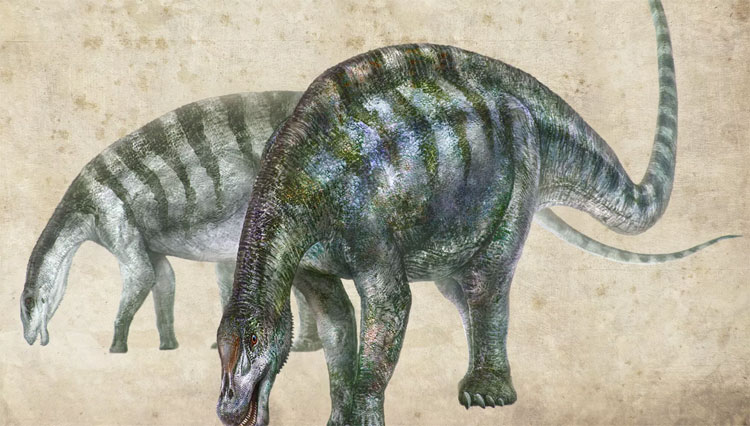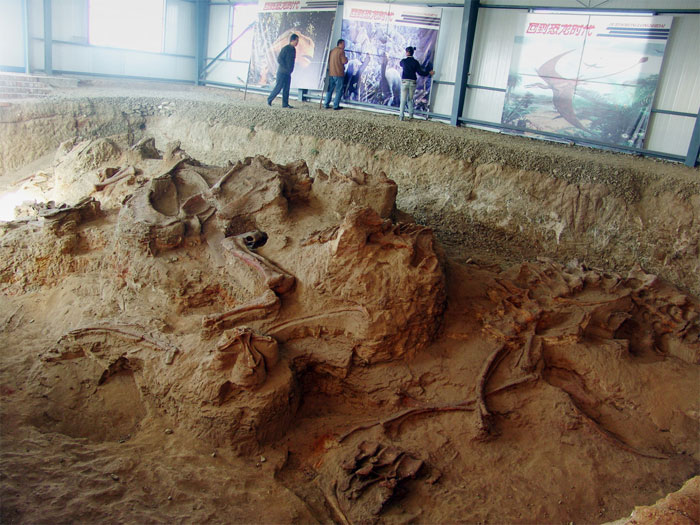Discovered the 'magic dragon' fossil in China
A 'magic dragon' fossil that was found in China can rewrite the history of the evolution of the largest beasts ever traveling on Earth.
The name of this giant herbivore means 'magic dragon from Linh Vu' - a place in China where fossils are found.

The picture depicts Lingwulong.
This species of dinosaur, thought to be about 17.5m long, is a close relative of other gentle giants including and and perhaps belonging to the group .
According to research published in Nature Communications, experts found that the bones in Linh Vu belong to eight to ten Lingwulong individuals.
The important thing about these findings is that it means that the sauropod dinosaurs, once thought to appear about 160 million years ago, have evolved 15 million years earlier than expected.
Research co-author Paul Upchurch, a paleontologist from the University of London, said: 'Previously, we thought that all high-end sauropod dinosaurs appeared about 160 million years ago and were fast. quickly diversifying and spreading across the planet in a short period of time maybe only about five million years. However, the discovery of Lingwulong means that this hypothesis is wrong and now we have to study with the idea that, in fact, this group of dinosaurs and its main parts appear earlier and slowly. than'.
According to lead author Xing Xu from the Chinese Academy of Sciences, Lingwulong probably lived in a warm and humid environment, many plants.

Fossils are found in Linh Vu, China - (Photo from Xing Xu).
They probably ate plants like conifers and ferns, and since their necks would not be as long as other sauropods, they probably ate the soft plants, as low as the teeth of their pig teeth.
Because of the discovery of many dinosaur bones in the same place, the researchers concluded that Lingwulong is a herd animal.
Previously, there was no other discovery about the sauropod group in East Asia because it was thought they evolved after Pangea - an ancient supercontinent that occupied most of the land area - due to a fracture, which began to form. The continent as we know it today.
Dr. Xu points out: 'Our findings suggest that East Asia is still connected to other continents at that time.'
- The mystery of the 'dragon fetus' in China has been solved
- Fossil sea monsters 75 million years of raw marks the enemy's teeth
- Chinese farmers discovered traces of black dragon on rocks
- 'Dragon fossils' nearly 10,000 meters long in the desert of Africa?
- The oldest dragon totem in China
- Discovered 6 species of dragon centipedes in China
- The man who possessed 'China first willing' shocked the ancient world
- Monkey skull fossil 6 million years old in China
- Fossil dragonflies lose their head 100 million years
- China found 7 million years old bird fossils
- Flying lizard eggs 120 million years in China
- The magic of Komodo dragon blood
 Discovered an ancient centipede fossil 99 million years old
Discovered an ancient centipede fossil 99 million years old Discovered bat-like dinosaurs in China
Discovered bat-like dinosaurs in China Discovered a 200-year-old bronze cannon of the coast
Discovered a 200-year-old bronze cannon of the coast Discover 305 million-year-old spider fossils
Discover 305 million-year-old spider fossils